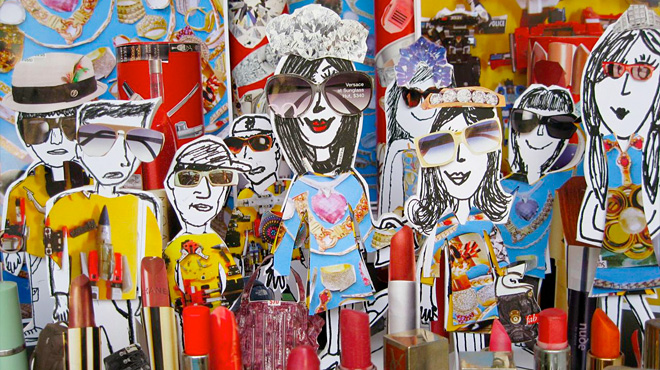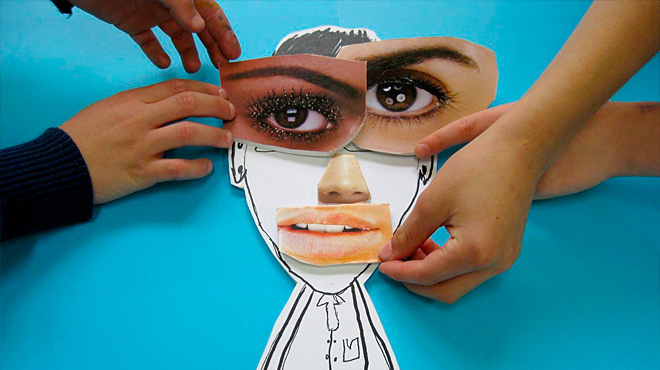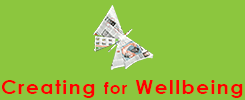Working for Wellbeing
Visual and physical theatre artist Rebecca Russell reflects on her experience of working within a wellbeing framework. As one half of the creative partnership The Becken Project (together with visual theatre artist Ken Evans), Rebecca worked on the student wellbeing project “Who’s in the Mirror?” as part of the Melbourne Catholic Education Office’s Community Arts program in 2009.
Rebecca Russell and Ken Evans have been collaborating since 2005. Rebecca is a director and devisor of new visual and physical theatre works as well as being an educator and researcher with ongoing interest in pedagogy. Ken Evans is a veteran visual theatre artist who has worked as a designer, puppeteer and puppet maker. He was co-founder and artistic director of the visual theatre company, Handspan.
Now operating as The Becken Project, Rebecca and Ken create original works in collaboration with children and other artists, with an emphasis on thinking, challenging perception and professional artistic and creative practice. All of their work is grounded in visual theatre skills and techniques, but the outcomes are varied and include short film, live theatre and permanent installations.
At an Artists Training Day in Melbourne in 2010, Rebecca spoke about the intersection between The Becken Project’s work, professional arts practice and children’s wellbeing. She highlighted “Who’s in the Mirror?” a student wellbeing project that the Becken Project undertook in a Melbourne Catholic School.

Reflections from an Artist Sitting under the Umbrella of Wellbeing
“Body image was not an easy topic for us artistically: it is real, it is serious, there is no easy access to fantasy and the abstract…”
The essence of what we do when we work with children is to explore and experiment with ways to engage them in our artistic and creative process. So all our projects with kids in some way have been about an in-depth experience in generating art, and the flow-on, we hope, is that through this experience our collaborators – the children – will have gained an entry point into not only generating but experiencing art.
We are interested in exploring the conceptual underpinning of making art. Our techniques include exploring philosophical and universal questions as stimulus for generating imagery. We recognise and value the integrity of children’s ideas and creativity and incorporate them into professionally guided artistic works. We believe that our approach is a good fit with what we knew of the wellbeing model and in fact we always like finding new boxes we can tick when we talk about our work, because much of the time it seems to be ‘other’: other is often the only box we fit! So it was nice to reflect on the wellbeing language and see that we do indeed fit here.
Our process has been evolving over the past 5–6 years and, by exploring ways to engage children in rigorous artistic and creative processes, we hope to provide them with an entry point into both generating and experiencing art. We are always experimenting with something we haven’t done before so each project is “real” for us in terms of us working as artists. We have never repeated a project, our work is always evolving.
That each piece is our work as much as the kids’ work is vital, because we are genuinely engaged in the artistic process, and it is through our genuine engagement that, hopefully, genuine and rigorous engagement also happens for the kids we are collaborating with. This is where I see our work as being a nice fit with wellbeing. The complex nature of the artistic and creative process offers a rich mix of experiences, skills, techniques, challenges, interactions, and so on.

There can be an expectation that we as artists enter these partnership projects being all things to all people – an expectation from myself as much as anything. And in the past I have tried to fit what I do with, for example, the curriculum or the brief and this has been the starting point for developing and proceeding with the project. I have found a much more productive and positive approach, which has a slightly different starting point: it can be subtle but it dramatically changes the way I work. The difference for me is to enter the project firmly from the perspective of an artist. This is really to do with trusting in the rich and complex nature of what it is that we, as artists, do.
My experience has led me to approach these projects with a major emphasis on what I best bring to the project and then to rely on and trust in the skills and specialisation of the other collaborators to connect with the other components of the project. I call it creative collaboration. And this is really at the heart of the way Ken and I work as The Becken Project when we collaborate with kids, teachers, institutions, schools, health professionals, and so on. Firstly we are artists, and secondly we collaborate (sometimes it’s not in that order).
A significant project I did under the umbrella of wellbeing was called “Who’s in the Mirror?” The project was an artistic and philosophical response to body image and self-esteem. It was a simple short film created with Years 5 and 6 from St Martin of Tours in Rosanna. It was funded by the Catholic Education Office (CEO) through a community arts program led by Judy Jack, a Student Wellbeing officer at the CEO.
We worked with five classes, a total of 180 kids. The project ran over three terms in 2009, with the majority of the work being done in second term. We also worked with a group of senior citizens from the parish. This project was incredibly challenging. I have not chosen to highlight it as a shining example of an arts/wellbeing/health partnership! I speak as an artist new to the area of mental health and wellbeing who learnt an awful lot from doing this project, and I have an interest in exploring the links with the arts, my practice and wellbeing.
We, as artists, were matched with a school who had identified (through their school review) student wellbeing as an area for development. The brief for the project was quite overwhelming. We were given pages of fabulous lists and goals and almost legal documents, including: school policies, procedures and practices; school community checklists; school improvement framework resources; data gathering tools for the school community sphere, and more.
We don’t come from a large arts organisation that already has its community arts and wellbeing strategies well documented and articulated. To be quite honest, when writing this I found it difficult to remember exactly what our brief was in terms of student wellbeing, community engagement and mental health. But I do have a very strong memory of knowing that our practice and the philosophy behind our work resonated with the brief for the project.

Our aim for this project, as always with our work, was to collaborate on an in-depth and original artistic project with the kids and the teachers. The school had identified self-esteem and body image as the topic they wished to explore through an arts project, having recognised the need for this issue to be addressed due to bullying in the school – which must be said was quite a challenge. Body image was not an easy topic for us artistically: it is real, it is serious, there is no easy access to fantasy and the abstract.
The school also wanted us to work with all year 5 and 6 students – 180 of them. This meant a major rethink for us, as we prefer to work with one class group in order to enable a more in-depth experience, more continuity and a more thorough integration of the project across the curriculum. This is an interesting issue: I think looking at models for enabling in-depth arts experiences in schools is really important.
Having been briefed on body image and the curriculum the 5/6s would be covering, we reflected and pondered a “way in” for us artistically. At this stage we did not consider how we were going to do this, or the logistics of working with the school and 180 kids. That would all come later… So, purely as artists, forgetting about wellbeing, curriculum, scaffolding, logistics, timetables… we pondered an artistic and philosophical response to body image and self esteem.
This is the part of the process that we bring to the project; this is our area of expertise. We decided on a short film rather than live performance due to the large number of kids involved: we just didn’t think that there would be a lot of artistic integrity in trying to write, design, make, rehearse and perform a puppet show with a cast of 180! (We, particularly Ken, can be a bit precious about seeing bad puppets waggled around with not enough rehearsal – puppeteers are a funny breed!)
Exactly what that outcome would be, we didn’t know. We had agreed on a short film, but part of making art is doing something that has never been done before, so there is an element of the unknown – which can be quite a challenge in a school setting when so much is outcome-driven. I will address this briefly later.
Ken and I work very much towards an outcome. This was something that was stated as not necessary in the goals of this project, but we see an outcome as important for the children: to experience their work presented in a ‘professional’ manner. We have found that while our projects can get tricky and complex – because that’s what happens when you are creating something – often the kids are involved in only certain aspects of the piece and it’s not until they see the finished product, and can see how all their work fits into the final picture, that they can fully appreciate what they have done. It is an important part of engaging in a “real” artistic process.

After much to-ing and fro-ing and research, we settled on using pop art, collage and assemblage as starting points, using print media as a metaphor. We made a series of artistic decisions to provide a starting point and a frame for the work, which would ultimately lead to an outcome.
The year 5/6s were doing a term’s work on body image and self-esteem and so the following term we worked with each class on making the film. Before they had finished their term’s work I recorded three philosophical discussions with small groups of the kids based on the philosophy for children “Community of Inquiry” educational model. We discussed questions each class had identified as significant arising from the work they had done throughout the term.
I edited this and then played the children’s discussion to a group of seniors from the parish. We then sat down and had a discussion where the seniors responded to what the children had said. I had to practically drag them there kicking and screaming, but once they were there I couldn’t shut them up – they were great.
From the recordings, Ken and I identified five salient themes (one for each class, conveniently), which gave us the framework for how we would engage the kids and teachers. We worked with each class twice for three-hour blocks – which is not a lot of time! So we broke the project into five parts: one for each class. So we faced a challenge: it was not possible for us to engage each group in the entire creative process or really in any in-depth way. But we still wanted to explore with the kids other ways of presenting some of the issues around body image and self esteem.
Our solution? We became a “production house,” and each class was responsible for a small component of the bigger picture. Then, within each class, individuals became responsible for smaller details within that component. We took on and explained, in detail, the roles of “executive producers” and that was the deal we made with the kids. They really enjoy working in a way that is how things are actually done “in real life,” so we used terms like “executive producers” and we called other students the “art department,” “designers,” “illustrators,” or whatever their role was as they worked on the film.
We opened each session with a production meeting – and called it that – where we would fill them in on the bigger picture and then discuss what they would be doing. They chose their roles based on what they were interested in and what they were good at – which was actually quite significant.

We gave them loads of examples of pop art, collage and assemblage as input and then developed with them the scenarios that were in the film. On a design level, we made basic sets of floor and backdrop that gave an overall scale to the production that suited the kids and provided continuity for the camera. The kids created the characters and settings for each scene and it was the scale that enabled all the art work to come from the kids. After that we organised a shooting schedule to fit in with drawing small groups out of classrooms over four days. At the end of each day’s shoot we reviewed the material, and it was then that our ideas began to form solidly about how the piece would run.
It’s interesting to note that it took until this point in the process – after we had finished working with the kids – for the “unknown” we had been living with to begin to dissipate. We knew it would: we knew we were working towards something and that there was something there. But by this stage I’m sure the kids and the teachers were beginning to wonder!
There’s a much bigger discussion to be had here about working with the unknown in a school setting. We’ve come up with some strategies but it’s a big challenge. Communication is a key; just knowing that some things are unknown is a good starting point. It’s part of creating something new! With it goes a good dose of trust for everybody involved.
Once we had all the art in the camera and a final edit on the soundtrack we generated a running order of images that synched with the soundtrack, and then added the seniors as breaks in-between each topic. Then we worked with an animator to edit and produce the final film.
How do I see the work we did with these kids as fitting with wellbeing?
It’s those quick and subtle moments when there is an exchange with one of the kids who knows what they want to do for the project, and it’s then that we can give them further input and encouragement and point them towards further delving into the topic or the art form – we can supply them with our repertoire of artistic knowledge. We might say: “What you need to look at is this…” and they do!
It’s when they are energised and focused and ready to really explore and experiment with ideas and form.
It’s reaching that level of engagement, getting to that point where the kids are into it and seeking and delving into the unknown—that’s the level of engagement we’re all looking for! The catch cry of The Becken Project is just that – we aspire to inspire, uplift and challenge.
